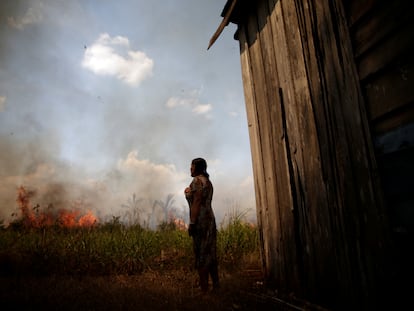Chana, the research station in the Peruvian jungle set up to rescue Amazonian languages
Of the 48 Indigenous languages in Peru, eight are in danger of extinction. In the eastern region of Ucayali, a group of linguists is working to keep them alive
In front of a celestial mural — where a cosmic vision of ayahuasca has been captured — Dr. Roberto Zariquiey recalls the exact moment that began his spiritual link to the Amazon.
In 1997 — when he was not yet of legal age — his university ethics professor thought that a group of students should visit a Shipibo community. It was his first experience with the jungle and, furthermore, his first plane trip. From that journey onwards, he would keep going back.
Now a linguist who has worked with 25 languages — from compiling lexical lists to writing books on grammar — Roberto found a father figure in Emilio Estrella, a member of the Indigenous Kakataibo people of Peru. Working together in Pucallpa — the capital of the eastern Peruvian region of Ucayali — the two men managed to increase the numbers of speakers of the Iskonawa language from five to 120.
On this scorching hot Thursday in October — like any other day in the Amazon — Dr. Zariquiey has completed a project that has been on his mind for a long time: installing a research station to study and preserve the languages in this part of the world.
It’s noon in the village of San José, in the district of Yarinacocha. Dozens of people have gathered at the Chana Research Station to celebrate its inauguration. The name comes from a local bird who imitates the sounds made by other birds. The land that the station is built on also has a special connotation: in this same area, a decade ago, the Iskonawa people received classes to relearn their language, as part of a project led by Dr. Zariquiey. Several of those former students are present this afternoon, such as Nelita Rodríguez Campos, a wise Iskonawa, who is an emblem of this revitalization process. She was one of the few from her community who survived upon leaving the forest and coming into contact with the city.
If Zariquiey is the manager, his wife, Mariana Poblete, is Chana’s coordinator. She handles the academic programming and the logistics. Poblete, born to a Venezuelan mother and Chilean father, grew up in Chile. After giving birth to her son in Boston, she was seduced by the Peruvian Amazon, where she says that she has reunited with the plants of her childhood.
During her time in Chile, this woman — who has curly hair like a leafy tree — focused her professional work on the Huarpe languages, which were considered dormant, because they had almost no speakers. Chana represents a peak in her life to try to reverse this erasure.
“In much of South America, many generations of natives were stigmatized, they suffered from racism and exclusion — they preferred to hide their Indigenous identity. This meant abandoning their languages and speaking only the Spanish that guaranteed them jobs in the cities. Thus, the transmission [of language] from parents to children was cut off. In addition to fear, it was mistakenly believed that speaking one language harmed the other,” explains Mariana Poblete, while breastfeeding her baby, a small ten-month-old. He’s known in the area as Tamasari, in honor of a request from an Iskonawa wise man, who renamed Roberto Zariquiey in a similar fashion.
The Chana Research Station has two pillars to keep the native languages alive: recreational activities and technology. In that sense, it has an eye tracker — a device that observes eye movements, to try to understand how a person cognitively processes language. “A language that has very long words, with many suffixes, is processed differently than a language with small words, such as Chinese. Each one has its grammatical peculiarities and, therefore, its psychological peculiarities. We’re studying the system for combining sentences that Shipibo has. It’s a very complex language,” Zariquiey notes. Both Iskonawa and Shipibo-Conibo belong to the Pano-Taconan language family.
Peru is a multicultural nation with 48 native languages, of which eight are in danger of extinction. The Taushiro language, for example, has only one speaker: a 74-year-old man named Amadeo García, who lives in Loreto, Peru’s northernmost region. Chana is a torch in a desolate context. A torch lit by the persistence of the team, but whose fire is sustained by the alliance of three institutions: the Pontifical Catholic University of Peru (PUCP), the Max Planck Institute and the University of Zurich.
“For a long time, in the field of psychology, research was done with white people who had Western education, instead of taking diversity into account. 70% of the studies have been done with those who represent 12% of the world’s population — that cannot be representative. The same thing has happened with linguistics. It’s not [scientifically] accurate,” laments Russell Gray, an evolutionary biologist and psychologist at the Max Planck Institute, during a visit to the village of San José de Yarinacocha. Along the same lines, Balthasar Bickel — from the Department of Comparative Language Science at the University of Zurich — points out how this adventure to delve into the vocabulary and sounds of other parts of the world arose: “We realized that we had to make an effort to understand all languages, not just a few. We’ve passed through [research stations] in Nepal, Canada, Vietnam. We welcome the fact that one now exists in Peru.”
For his part, Aldo Panfichi — a Peruvian, who is vice-rector for research at the PUCP — predicts that the Chana project will be full of vitality. “We have to be less Eurocentric, we need to work more on our roots,” he emphasizes.
Adelina Maldonado — chosen by Forbes as one of the most powerful Peruvians of 2023 — says that, many years ago, her aunt (a well-known shaman in the area) told her that she was going to meet “important people” and that they would live in her house. The prophecy has been fulfilled: Chana has been built on a plot of land that once belonged to her and that she used to rent out. She feels that it’s her way of contributing to the Shipibo-Conibo people. “I’m proud of my ancestors and my customs. I’m excited that work is being done on our language, because that’s how we connect with nature and our surroundings,” Maldonado says. Her face and that of her aunt — Olivia Arévalo — are painted on the mural in Chana’s main room.
The research station is preparing to host projects and build knowledge. The commitment is to involve the local communities and bolster them alongside Chana.
Sign up for our weekly newsletter to get more English-language news coverage from EL PAÍS USA Edition
Tu suscripción se está usando en otro dispositivo
¿Quieres añadir otro usuario a tu suscripción?
Si continúas leyendo en este dispositivo, no se podrá leer en el otro.
FlechaTu suscripción se está usando en otro dispositivo y solo puedes acceder a EL PAÍS desde un dispositivo a la vez.
Si quieres compartir tu cuenta, cambia tu suscripción a la modalidad Premium, así podrás añadir otro usuario. Cada uno accederá con su propia cuenta de email, lo que os permitirá personalizar vuestra experiencia en EL PAÍS.
¿Tienes una suscripción de empresa? Accede aquí para contratar más cuentas.
En el caso de no saber quién está usando tu cuenta, te recomendamos cambiar tu contraseña aquí.
Si decides continuar compartiendo tu cuenta, este mensaje se mostrará en tu dispositivo y en el de la otra persona que está usando tu cuenta de forma indefinida, afectando a tu experiencia de lectura. Puedes consultar aquí los términos y condiciones de la suscripción digital.
More information
Archived In
Últimas noticias
Tiger Woods turns 50: Will he continue playing on the PGA Tour or take a back seat?
The surreal journey of James Nnaji, the Barcelona youth player selected in the NBA Draft who ended up in the NCAA
Trump claims peace in Ukraine is near, but Moscow suggests otherwise
A survivor’s account of the Interoceanic Train accident: ‘We were scared because of the speed on the curve’
Most viewed
- Oona Chaplin: ‘I told James Cameron that I was living in a treehouse and starting a permaculture project with a friend’
- Reinhard Genzel, Nobel laureate in physics: ‘One-minute videos will never give you the truth’
- Sinaloa Cartel war is taking its toll on Los Chapitos
- Why the price of coffee has skyrocketed: from Brazilian plantations to specialty coffee houses
- Chevy Chase, the beloved comedian who was a monster off camera: ‘Not everyone hated him, just the people who’ve worked with him’











































